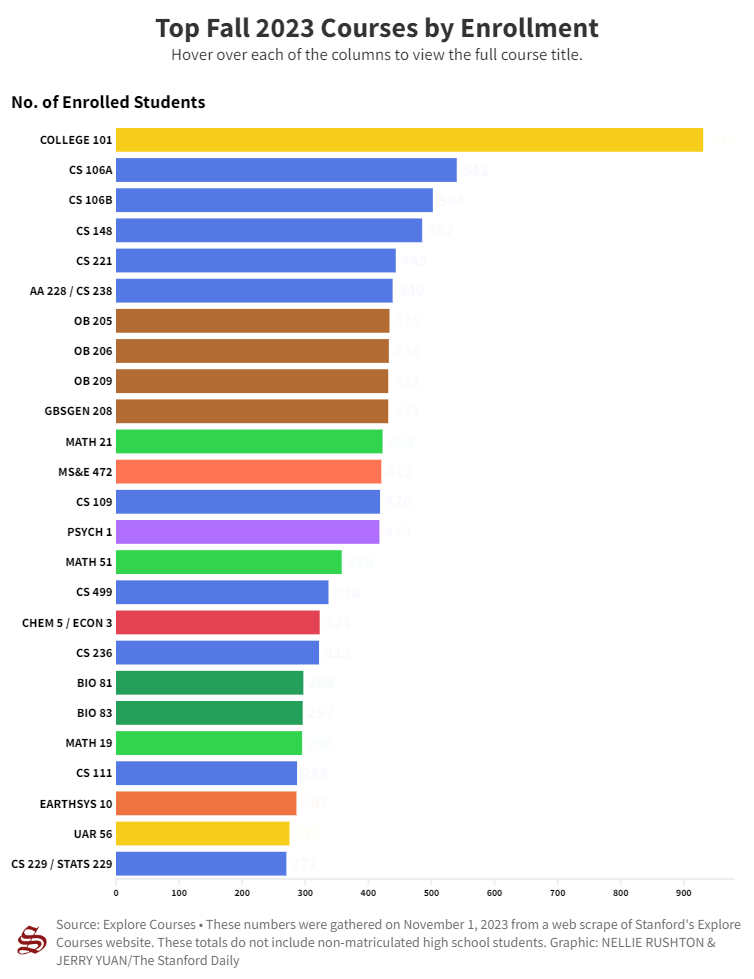STEM subjects continue to comprise the courses with the highest enrollment for this Autumn Quarter, according to the University’s ExploreCourses platform.
Similar to the results from last spring, five out of the overall top 10 courses were computer science (CS) courses. Three out of these five courses cover foundational AI ideas (e.g. probability theory and machine learning).
With 934 enrolled students, COLLEGE 101: “Why College? Your Education and the Good Life” is the most enrolled class this quarter, taken by a majority of the current frosh class. This first-year course is required to fulfill the university’s Civic, Liberal and Global Education requirements. Throughout this class, students are challenged to “examine your own life, to question how and why certain decisions about your education were made,” according to the course description.
The second most enrolled course this quarter is CS106A: “Programming Methodology” with 542 enrolled students. This course provides an introduction to programming delivered through lectures and small-group sections, supplemented by optional help hours with section leaders (“LAiR”). It covers the fundamental features of the Python language: strings, decomposition, functions, good style and more.
CS106B: “Programming Abstractions” carries 504 students as the thirdmost-enrolled course. In this follow up to CS106A, students translate Python knowledge from 106A to the C++ language with novel techniques to solve more complex problems.
CS148: “Introduction to Computer Graphics and Imaging” continues the CS course trend as the fourth most-enrolled course this quarter. Professor Ron Fedkiw credits his Head TA, Kevin Li, who has been with the class for a number of years, and positive word of mouth spreading after the first day to the spike in enrollment from past years. Fedkiw said that his course’s popularity comes from interest with the field’s growth, as “the AR and VR component, in addition to movies and games, just saturates the notion of graphics and visuals.” He says what differentiates the course from other CS courses is that it embraces students’ “creative spark,” satisfying one of Stanford’s Ways of Thinking, Ways of Doing requirements as students work towards creating their own image.
The fifth highest-enrolled course and most enrolled graduate school course is CS221: “Artificial Intelligence: Principles and Techniques.” Meeting in the NVIDIA Auditorium, 445 students engage with the fundamental ideas of implementing AI systems, from machine learning to graphical models.
At number six is AA228/CS238: “Decision Making under Uncertainty,” a class that teaches students about computational methods that draw on mathematical theories to make better decisions, with applications ranging from air traffic control to autonomous vehicles, according to the course’s website. Students have the freedom to complete the course in-person or virtually.
Four courses exclusively designed for students in the Graduate School of Business (GSB) round out the top 10 with more than 430 students enrolled in each. OB205: “Managing Groups and Teams” explores the inner workings of teams, helping students to identify issues within teams and providing them with strategies to optimize group operations. OB 206: “Organizational Behavior,” is grounded in insights from social psychology. Theory and research from the field is translated to practice in organizational settings, examining concepts like individual motivation and interpersonal communication.
In OB 209: “Leadership Laboratory,” students work in small squads, engaging in “experiential exercises, case role plays and team discussions and negotiations,” according to the course description. Lastly, GSBGEN208: “Leading with Values,” rounds out the top 10, offering first-year MBA students strategies and analytical tools to help students lead more ethically and efficiently. Students refine their own ethical stance through “class exercises, rigorous discussion, and personal reflection,” according to the course description.
Just outside of the top 10 at the 13th highest enrollment, CS 109: “Introduction to Probability for Computer Scientists” equips students with “new mathematical ideas that allow students to write really interesting programs,” professor Chris Piech ’10 M.S. ’11 Ph.D. ’16 said. Building on excitement from his “lovely students” and “lovely TAs,” the course teaches unique skills, like “thinking under uncertainty and representing what you don’t know.” Piech said that he thinks that popular interest in similar courses has to do with the “transformative technology change in the last year with large language models” that offers an opportunity to solve problems with AI that weren’t previously seen as possible.
CHEM 5/ECON 3/SOC 5: “Big Ideas: Conversations with Stanford’s Own Nobel Laureates & MacArthur ‘Genius’ Fellows” has 324 enrollments as Stanford’s 17th most enrolled course. According to professor Ran Abramitzky, this events series where students converse with Nobel Laureates and MacArthur fellows is designed to “discuss big ideas and inspire students.” In addition, these conversations are designed to be relatable, often discussing moments of failures and frustrations and offering advice. “It is [an] incredible opportunity for undergraduate students to interact with some of Stanford’s most prominent faculty,” Abramitzky said.
This article has been updated to adjust for double-counting related to GSBGEN 208 in ExploreCourses. The Daily regrets this error.
